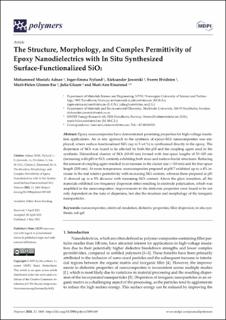| dc.contributor.author | Adnan, Mohammed Mostafa | |
| dc.contributor.author | Nylund, Inger-Emma | |
| dc.contributor.author | Jaworski, Aleksander | |
| dc.contributor.author | Hvidsten, Sverre | |
| dc.contributor.author | Ese, Marit-Helen Glomm | |
| dc.contributor.author | Glaum, Julia | |
| dc.contributor.author | Einarsrud, Mari-Ann | |
| dc.date.accessioned | 2021-05-07T06:36:20Z | |
| dc.date.available | 2021-05-07T06:36:20Z | |
| dc.date.created | 2021-05-01T12:03:43Z | |
| dc.date.issued | 2021 | |
| dc.identifier.citation | Polymers. 2021, 13 (9), 1469-?. | en_US |
| dc.identifier.issn | 2073-4360 | |
| dc.identifier.uri | https://hdl.handle.net/11250/2754038 | |
| dc.description.abstract | Epoxy nanocomposites have demonstrated promising properties for high-voltage insulation applications. An in situ approach to the synthesis of epoxy-SiO2 nanocomposites was employed, where surface-functionalized SiO2 (up to 5 wt.%) is synthesized directly in the epoxy. The dispersion of SiO2 was found to be affected by both the pH and the coupling agent used in the synthesis. Hierarchical clusters of SiO2 (10–60 nm) formed with free-space lengths of 53–105 nm (increasing with pH or SiO2 content), exhibiting both mass and surface-fractal structures. Reducing the amount of coupling agent resulted in an increase in the cluster size (~110 nm) and the free-space length (205 nm). At room temperature, nanocomposites prepared at pH 7 exhibited up to a 4% increase in the real relative permittivity with increasing SiO2 content, whereas those prepared at pH 11 showed up to a 5% decrease with increasing SiO2 content. Above the glass transition, all the materials exhibited low-frequency dispersion effect resulting in electrode polarization, which was amplified in the nanocomposites. Improvements in the dielectric properties were found to be not only dependent on the state of dispersion, but also the structure and morphology of the inorganic nanoparticles. | en_US |
| dc.language.iso | eng | en_US |
| dc.publisher | MDPI | en_US |
| dc.rights | Navngivelse 4.0 Internasjonal | * |
| dc.rights.uri | http://creativecommons.org/licenses/by/4.0/deed.no | * |
| dc.title | The Structure, Morphology, and Complex Permittivity of Epoxy Nanodielectrics with in Situ Synthesized Surface-Functionalized SiO2 | en_US |
| dc.type | Peer reviewed | en_US |
| dc.type | Journal article | en_US |
| dc.description.version | publishedVersion | en_US |
| dc.source.pagenumber | 1469-? | en_US |
| dc.source.volume | 13 | en_US |
| dc.source.journal | Polymers | en_US |
| dc.source.issue | 9 | en_US |
| dc.identifier.doi | 10.3390/polym13091469 | |
| dc.identifier.cristin | 1907571 | |
| dc.relation.project | Norges forskningsråd: 259866 | en_US |
| dc.description.localcode | Copyright: © 2021 by the authors. Licensee MDPI, Basel, Switzerland. This article is an open access article distributed under the terms and conditions of the Creative Commons Attribution (CC BY) license (https:// creativecommons.org/licenses/by/ 4.0/). | en_US |
| cristin.ispublished | true | |
| cristin.fulltext | original | |
| cristin.qualitycode | 1 | |

